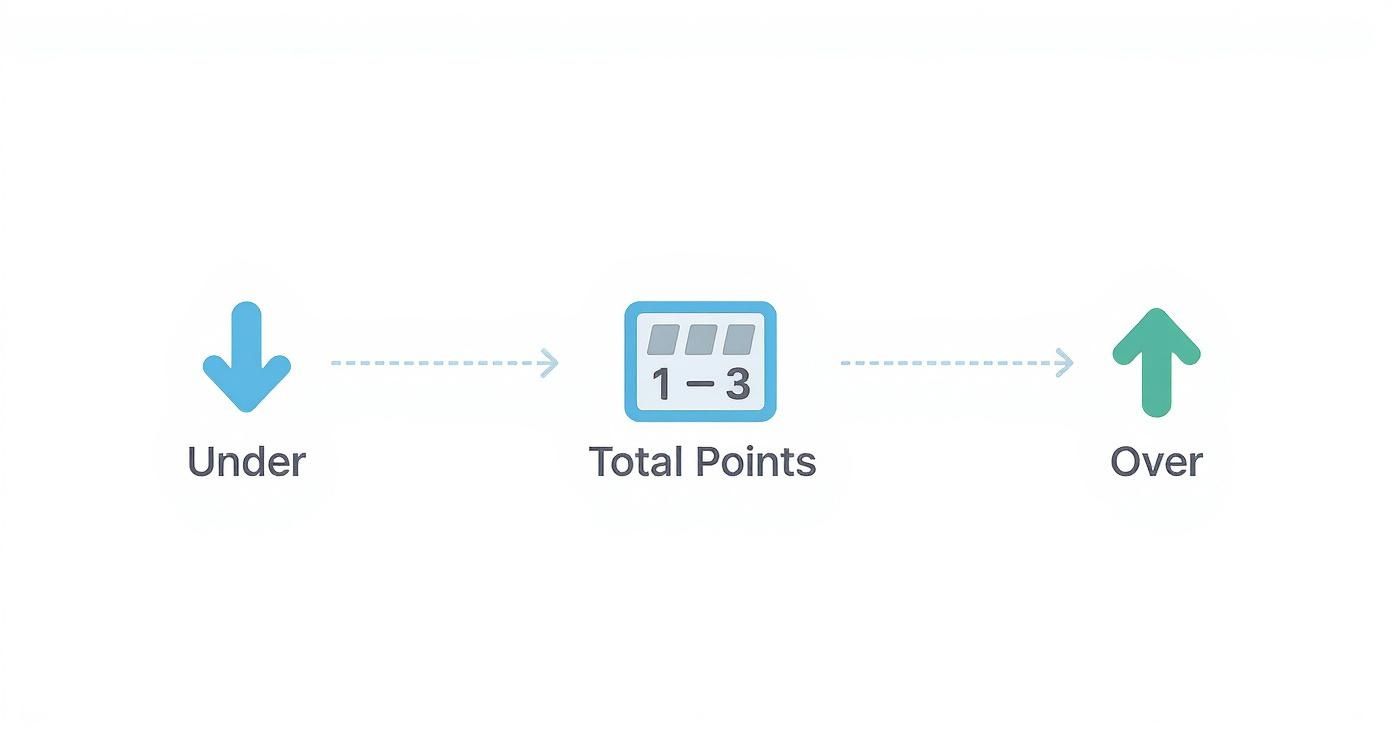An Over/Under bet, often just called a 'total,' is one of the most popular wagers out there for a simple reason: you don't have to pick a winner. Instead, you're just calling your shot on whether the combined score of both teams will go higher (Over) or lower (Under) than the number set by oddsmakers at sites like BetUS or Bovada.
This is a go-to for bettors who have a good feel for a game's tempo but aren't sold on which team will come out on top.
What Is an Over Under Bet
If you’re just getting into sports betting, the Over/Under is the perfect on-ramp. It strips away the pressure of picking a side and lets you focus on the game’s narrative. Are you expecting a high-flying offensive shootout or a gritty, defensive slugfest? That’s all you need to decide.
Let’s use an NBA game as an example. The Lakers are playing the Celtics, and the total is set at 220.5 points.
If you bet the 'Over' and the final score is 115-110 (a combined 225 points), you win. Simple. But if the game ends 110-105 (a combined 215 points), the 'Under' bettors are the ones cashing their tickets. This concept is a cornerstone of betting everywhere, especially in football and basketball, because it rewards reading the flow of the game over simple team loyalty. If you want to dive deeper into the basics, check out our guide on sports betting lingo.
The Core Components of a Total Bet
Breaking down a total bet is easy once you see the moving parts. The oddsmakers at sportsbooks like Sportsbetting.ag don’t just pull this number out of thin air; they use a ton of data to set a line that they hope gets about half the money on the Over and half on the Under. That’s why understanding the fundamentals is so crucial.
The real beauty of the Over/Under is how versatile it is. Bettors who are sharp at analyzing things like team pace, defensive stats, or even how the weather might affect scoring often find a real edge here.
To make it even clearer, let's break down the key pieces of an Over/Under bet.
Over Under Betting Quick Facts
This table puts all the essential info in one place, using a common NFL total as an example.
| Component | What It Means | Example (NFL Game: 45.5) |
|---|---|---|
| The Total | The specific number set by the sportsbook. | 45.5 points |
| The Over Bet | A wager that the combined final score will be higher than the total. | The final score is 28-20 (48 total points). The 'Over' wins. |
| The Under Bet | A wager that the combined final score will be lower than the total. | The final score is 21-17 (38 total points). The 'Under' wins. |
As you can see, it's a straightforward bet with just three core elements to track: the line itself, and which side of it you think the final score will land on.
How Oddsmakers Set the Total
Ever wondered how sportsbooks like MyBookie and BetOnline land on that one specific number for a game's total? It’s not a wild guess. It's a fascinating mix of high-level math, deep statistical analysis, and a healthy dose of expert intuition. Oddsmakers don't just pull numbers out of thin air; they build the line from the ground up.
The whole process starts with a baseline number crunched from historical data and some pretty sophisticated analytics. Think of this as the "pure" number—the oddsmaker's unbiased prediction of the final score before any real-world chaos gets factored in.
Key Factors in Setting the Line
From that starting point, oddsmakers at shops like Sportsbetting.ag and Bookmaker.eu begin refining the line by weighing dozens of variables. The real goal here isn't to be perfectly correct but to create a number that attracts action on both sides of the bet.
They're digging into things like:
- Offensive and Defensive Efficiency: How good is each team at scoring points, and how good are they at stopping the other guys? This is the bread and butter of any total.
- Pace of Play: Some teams play at a breakneck speed, creating more possessions and, naturally, more chances to score. A faster pace almost always means a higher total.
- Recent Performance Trends: Is a star player on a hot streak? Or has a defense suddenly become a brick wall over the last few games?
- Head-to-Head History: Certain matchups just have a history of turning into high-scoring shootouts, while others are notorious defensive slugfests.
This infographic breaks down the basic idea of an over under in sports betting. At its core, you're betting on one of two simple outcomes.

The image really simplifies the bet down to its core choice: will the combined score be above or below the sportsbook’s number?
Adjusting for Real-World Variables
Once the data spits out a number, the human element takes over. This is where the real art of oddsmaking comes in, as they account for all the messy, real-world stuff that an algorithm can’t quite nail down.
External factors can swing a total in a big way. A forecast calling for 25 mph winds at Lambeau Field is going to push an NFL total down hard. Likewise, a last-minute injury to a star point guard can crater an NBA total. Oddsmakers also have to consider things like coaching styles, travel fatigue, and even which referee crew is assigned to the game. If you really want to go down the rabbit hole, our guide explains in detail who creates NFL betting lines and the incredibly complex process they follow.
Here's the secret: the ultimate goal for sportsbooks like Bovada or Xbet isn't to perfectly predict the final score. Their main objective is to set a total that gets roughly equal money bet on both the 'Over' and the 'Under'.
When they get that balance right, the sportsbook locks in a guaranteed profit from the commission they charge on losing bets—what we call the juice or vig. Understanding that motivation is the first step to finding value and beating the books at their own game.
Placing Your First Over Under Bet
Alright, you’ve got the theory down. Now it’s time for the fun part—getting some skin in the game and placing your first totals bet. The great news is that this process is dead simple on just about any major offshore sportsbook.
While the color scheme and logos might change from MyBookie to BetAnything, the bones of how you place a bet are basically the same everywhere. Let’s walk through it together using BetUS as our example, since they have a really clean, beginner-friendly layout. In just a few clicks, you'll be locked in.
A Step-By-Step Guide to Placing a Total Bet
Seriously, placing an over under bet is as easy as picking a game and clicking a button. Here’s exactly how it’s done.
- Navigate to Your Sport: Log in, head to the main sportsbook, and find the league you’re interested in—NFL, NBA, you name it.
- Select Your Game: Scan the list of upcoming matchups and click on the one you've got your eye on.
- Find the Total Column: The game page will show the main betting lines. You’re looking for the column labeled 'Total' or 'O/U', which is almost always right next to the point spread and moneyline.
- Make Your Selection: See the number you like? Just click on the 'Over' or 'Under' box that matches your pick. That’ll automatically add the wager to your bet slip.
- Confirm Your Bet Slip: Your bet slip will pop up, usually on the right side of the screen. Punch in how much you want to risk (your stake), see what you stand to win, and hit the 'Place Bet' button to make it official.
Here’s a look at the main sportsbook menu at BetUS. You can see how clearly the different sports are listed down the left-hand side, making it a breeze to get where you need to go.

This kind of clean navigation is what you want to see. It lets you get from login to locked-in bet in under a minute.
Pro Tip: Always, always double-check your bet slip before you confirm it. This is your last chance to catch a simple mistake, like picking the wrong side or typing an extra zero on your stake. Taking two seconds to verify can save you a world of hurt.
Once you’ve done this once, you’ll be a pro. The process is virtually identical at other top sites like Xbet or Bet105. The industry has a pretty standard layout, so you can jump between books without missing a beat.
Developing a Winning Totals Strategy
Alright, knowing what an over under in sports betting is is one thing. Actually making money from it? That's a whole different ballgame.
A winning totals strategy isn't about hunches or gut feelings. It's about thinking like an analyst, digging into the data, and finding angles the oddsmakers at places like Bookmaker.eu and Cosmobet might have missed.
Success starts with a simple but powerful concept: pace of play. Think about an NBA team that loves to run and gun, getting up shots early in the shot clock. More possessions almost always mean more scoring opportunities, which naturally pushes the needle toward the Over.
On the flip side, picture a methodical NFL team that just wants to pound the rock. They chew up the clock, limiting possessions for everyone and making the Under a much more appealing bet.
Finding Your Edge with Advanced Metrics
To really get an edge, you have to look beyond the basic points-per-game stats everyone else sees. Digging into offensive and defensive efficiencies gives you a much sharper picture of what a team is truly capable of.
For instance, a team might have a low points-per-game average, but their offensive efficiency rating is through the roof. This tells you they aren't bad at scoring; they just play at a snail's pace. That's where you find real value.
Look for these kinds of situational spots:
- Team Efficiency: In basketball, check out points scored per 100 possessions. In football, look at yards per play. These numbers strip away the pace factor and show you who is really good.
- Situational Trends: How does a team play on the second night of a back-to-back? Or in freezing cold weather? These are the spots where casual bettors get burned and sharp bettors clean up.
- Recent Performance: Season-long stats can be misleading. A team's performance over the last 5-10 games is a much better indicator of their current form.
The single most important habit for any serious totals bettor is line shopping. The odds and totals will be different across various offshore sportsbooks, and that half-point difference is everything. A total of 47 at MyBookie versus 47.5 at BetOnline can literally be the difference between cashing a ticket and a painful push or loss.
The Importance of Line Shopping and Key Numbers
This idea of comparing lines is absolutely critical for long-term profit. Having accounts at a few different sportsbooks like Bovada, BUSR, and Sportsbetting.ag lets you consistently hunt for the best number on any given game. If you want to dive deeper, our detailed guide on sports betting odds comparison is a must-read for getting the most value from every bet.
In some sports, especially football, certain numbers are way more important than others. We call these 'key numbers' because they crop up all the time as final combined scores.
For NFL totals, the biggest key numbers to watch are:
- 41: Think scores like 24-17 or 21-20.
- 44: Often comes from finals like 24-20 or 27-17.
- 47: A very common result from games ending 27-20 or 30-17.
- 37: Another big one, from scores like 20-17 or 27-10.
When you see a total sitting right on one of these numbers, any line movement is huge. Being able to bet Under 41 before it drops to 40.5, or grabbing the Over at 44 before it moves to 44.5, gives you a massive statistical advantage. Mastering these little details is what separates the pros from the amateurs.
Key Over Under Factors for Major Sports
A winning approach to an over under in sports betting isn't just about understanding the basic concept. You have to get into the weeds of each specific sport. Every game has its own rhythm, its own set of variables that push the score up or down. Getting a feel for these nuances is what separates the casual bettor from the sharp who consistently finds value at sportsbooks like BetOnline or BUSR.
What moves the needle on an NFL total is a completely different world from what drives an NBA score. Spotting those differences is the key to finding an edge. A smart totals bettor knows exactly what to look for before ever clicking the "place bet" button.

Football and Basketball Nuances
When it comes to the NFL, outside factors have a massive impact. Weather is probably the single biggest mover of a total. High winds, snow, or a heavy downpour can completely neutralize a high-powered passing attack, making the Under a much more attractive play. Don't forget about divisional rivalries, either—those games tend to be ugly, low-scoring slugfests because the teams know each other’s playbooks inside and out.
Basketball, on the other hand, is an indoor game where pace and efficiency are everything. You're looking at things like coaching styles and weird scheduling spots. A team playing on the second night of a back-to-back often has tired legs, which almost always means lazy defense and more points. The volatility of three-point shooting is another huge one; a team that lives and dies by the three can see its totals swing wildly from one game to the next.
The real edge comes from understanding that while most public betting resources focus on win-loss records, over/under outcomes are often less intuitive. They're more influenced by variables like weather, injuries, referee tendencies, and coaching styles.
Baseball and Soccer Dynamics
For MLB, your analysis has to start with the starting pitchers. It's non-negotiable. If you've got two aces on the mound, you can almost guarantee the sportsbook will set a low total. Beyond that, the ballpark itself is a massive factor. A game at hitter-friendly Coors Field will have a much higher line than one at a pitcher's paradise like Petco Park. Even the home plate umpire's tendencies can shift a total; a tight strike zone means more walks, more base runners, and ultimately, more runs.
Soccer totals generally revolve around the magic number of 2.5 goals. Here, you have to know the personality of the league you're betting. The Premier League, for example, has become way more attack-focused in recent years, pushing totals higher. Meanwhile, a league like Italy's Serie A still carries a reputation for defensive, tactical chess matches. In soccer, things like a team's current form or how much a cup match matters can completely change the expected flow of the game.
Many bettors just stick to simple moneyline odds, but the real complexity—and opportunity—can be found in totals. Just look at the NBA, where the explosion in pace and three-point shooting has caused average totals to skyrocket over the last decade. It's a similar story in European soccer, where attacking football is the new norm. You can spot these trends yourself when getting ready to place wagers at sites like Sportsbetting.ag or Xbet.
Comparing Totals Factors Across Sports
To really make a go of it long-term, you absolutely have to tailor your homework to the specific sport you're betting. What's a game-changer in one sport might mean nothing in another.
Below is a quick-reference table breaking down the most important variables to keep in mind, whether you're betting at an offshore book like Bookmaker.eu or Cosmobet.
Key Over Under Factors by Sport
| Sport | Primary Factors | Secondary Factors |
|---|---|---|
| NFL | Weather, Offensive/Defensive Line Play, Quarterback Quality | Divisional Rivalries, Prime-Time Game Pressure, Coaching Tendencies |
| NBA | Pace of Play, Three-Point Shooting Volume, Offensive Efficiency | Back-to-Back Games, Key Player Injuries, Referee Crew Assignments |
| MLB | Starting Pitching Matchup, Ballpark Dimensions, Bullpen Strength | Umpire Strike Zone, Weather (Wind/Humidity), Lineup Construction |
| Soccer | Team Tactics (Attacking vs. Defensive), League Scoring Trends | Player Form, Match Importance (League vs. Cup), Red Card Potential |
As you can see, each sport has its own unique puzzle. The bettors who take the time to learn these pieces are the ones who end up with a fatter bankroll.
Got Questions About Over Under Betting? We've Got Answers.
Once you start digging into over under in sports betting, you’re bound to run into a few tricky situations. What happens when a game goes to overtime? What in the world is a "push"? Getting a handle on these edge cases is what separates a confused bettor from a confident one, especially when you're using top offshore sportsbooks like MyBookie or BetUS.
Think of this as your go-to guide for those "what if" moments. We’ll clear up the most common points of confusion so you can bet without any unwelcome surprises.
What Happens If a Game Goes to Overtime?
This is easily one of the first questions new bettors ask, and thankfully, the answer is simple: overtime almost always counts.
Whether it’s an extra inning in baseball, an OT period in basketball, or an extra quarter in football, any points scored during that extended playtime get added to the final total. Sportsbooks like BetAnything and Sportsbetting.ag see the game as one complete event, from the first whistle to the last.
So, if you bet Over 45.5 in an NFL game and the score is tied 21-21 when the fourth quarter ends, don't sweat it. That game-winning field goal in overtime just cashed your ticket. The only time this isn't the case is for very specific wagers like "Regulation Time Only" bets, but for a standard game total, overtime can be your best friend.
Understanding a Push in Totals Betting
Ever wonder what happens if the final score lands exactly on the sportsbook's number? That's what we call a push, and it's basically a tie between you and the house.
Let's say you bet on Over 48 points in a game at Bovada, and the final score is a nail-biting 28-20. The total is exactly 48. In this case, your bet is a push. You don't win, but you don't lose either—your original stake is just returned to your account. This is precisely why you see so many totals with a half-point (like 48.5), as it makes a push impossible.
A push isn't a win or a loss; it's a do-over. Your stake is returned, and it's as if the bet never happened. While frustrating if you were close to a win, it's a safety net that protects your bankroll.
Don't think of a push as some rare event, either. In a sport like the NFL, it's not uncommon for 5–7% of games to end in a push against the total each season. It’s just part of the betting landscape.
How Does Live Betting Affect Over Under Odds?
Live betting throws the old playbook out the window and makes totals betting a dynamic, real-time game. As soon as a match starts, sportsbooks like BetOnline and Bookmaker.eu start adjusting the over/under line based on what's happening on the field.
If the first quarter turns into a high-scoring shootout, you'll see that live total climb. If it's a defensive slugfest with punts galore, the total will drop fast. This gives you a massive advantage, allowing you to react to the flow of the game. If you notice one team's star player is off their game or the pace is way faster than anticipated, you can jump on a new live total to double down or even hedge your original bet.
For example, look at a trend like Thursday Night Football. Data from 2019–2024 shows the average total drops from 46.22 in Weeks 1–5 to just 43.57 by Weeks 12–17 as teams get worn down. If you spot patterns like this, you can make smarter live wagers. You can learn more about NFL betting trends and use that knowledge to your advantage.
At USASportsbookList, we provide detailed reviews and comparisons of the top offshore sportsbooks to help you find the best odds, bonuses, and features for your betting style. Make smarter, more informed wagers by exploring our expert guides today at https://usasportsbooklist.com.


















